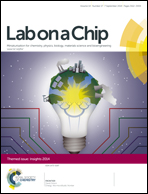Research highlights: increasing paper possibilities
Abstract
In this issue we highlight three recent papers that demonstrate new strategies to extend the capabilities of paper microfluidics. Paper (a mesh of porous fibers) has a long history as a substrate to perform biomolecular assays. Traditional lateral flow immunoassays (LFAs) are widely used for rapid diagnostic tests, and perform well when a yes or no answer is required and the analyte of interest is at relatively high concentrations. High concentrations are required because usually only a small volume of analyte-containing fluid flows past the detection region, leading to a limited signal. Further, the small pores within paper matrices prevent the use of paper to control the flow of larger particles and cells, limiting the use of paper microfluidics for cell-based diagnostics. The work we highlight addresses these important unmet challenges in paper microfluidics: enriching low concentration analytes to a higher concentration in a smaller volume that can be processed effectively, and using paper to pump flows in larger channels amenable to cells. Applying these new approaches may allow diagnosis of disease states currently technically unachievable using current LFA systems, while maintaining many of the “un-instrumented” advantages of an assay on self-wicking paper.


 Please wait while we load your content...
Please wait while we load your content...